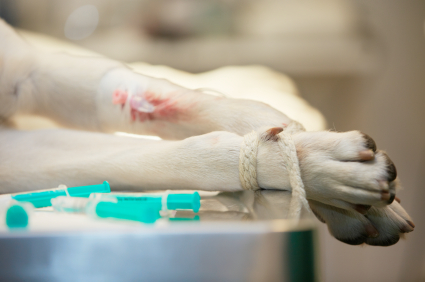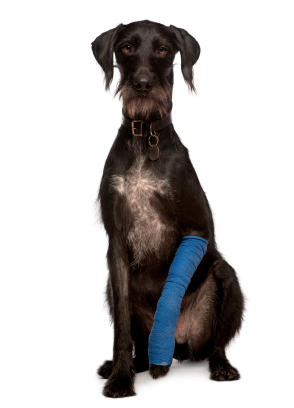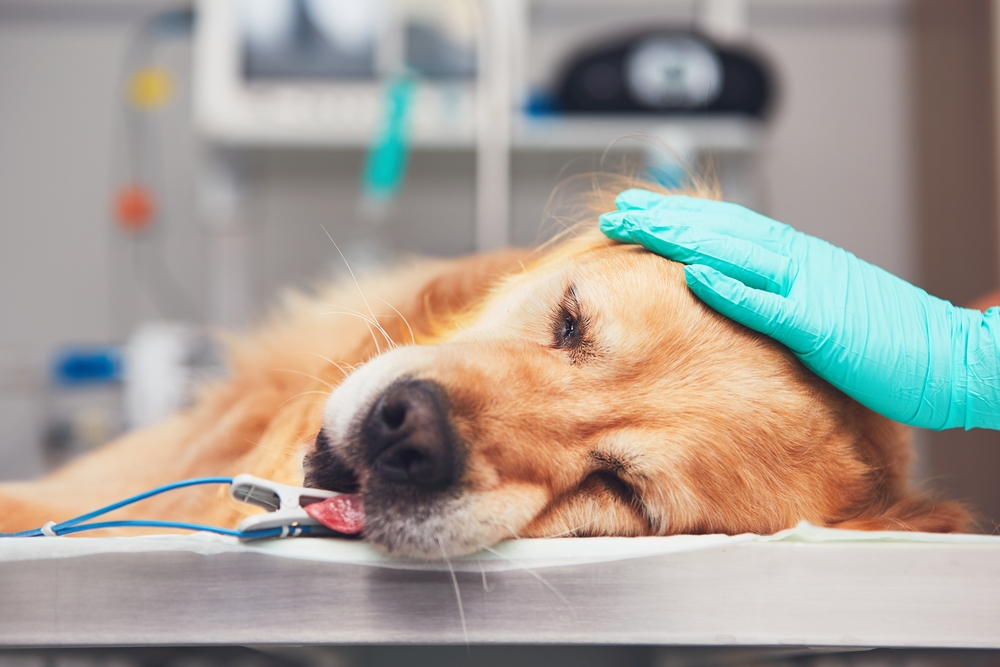Search Results for ‘weight’
Xylitol: A Hidden Holiday Danger for Pets

Can you spot the Xylitol in this photo?
…Neither can your pet.
What do the fruitcake you made for your diabetic great-aunt Betty, the pack of gum in your stocking, and the plate of holiday cookies that your neighbor dropped off have in common? All of them may contain the artificial sweetener Xylitol, a dangerous and deadly substance for dogs. Xylitol is becoming more and more commonly utilized, which makes it important for pet owners to be on the defense.
What is Xylitol?
Xylitol is a sugar substitute that is found in items such as sugar-free gum, baked goods, and oral hygiene products. In people it is absorbed very slowly so there are no ill effects. In dogs, however, the substance is absorbed within 30 minutes, causing the body to release a large rush of insulin. This results in a life-threatening drop in blood sugar. Besides this, Xylitol can also have severe effects on the liver. Continue…
Pet Emergencies: Prevention and Management
 Veterinary emergencies can arise, often without warning, at any time of the day or night, leaving you in a state of panic. The following things should be considered before pet emergencies happen. Continue…
Veterinary emergencies can arise, often without warning, at any time of the day or night, leaving you in a state of panic. The following things should be considered before pet emergencies happen. Continue…
Limping Pet: Emergency or Not?

It can be hard to know when a gimpy pet means an emergency. It never fails, your dog or cat always gets hurt at the most inconvenient time. Your regular vet may not be open, or you might have a long list of things to do. Continue…
Patellar Luxation: Your Pet’s “Trick” Knee
 Patellar luxation, or the tendency of the knee cap to dislocate, is a relatively common problem in our pets, particularly small breed dogs. Continue…
Patellar luxation, or the tendency of the knee cap to dislocate, is a relatively common problem in our pets, particularly small breed dogs. Continue…
New Year’s Resolutions: Tackling Pet Obesity
 This time of year, many of us are thinking of our New Year’s Resolutions. Maybe you are going to quit smoking, make a commitment to hit the gym more often, or spend more time with your kids. New Year’s Resolutions aren’t just for people, though. Your pet may have some life changes to make as well!
This time of year, many of us are thinking of our New Year’s Resolutions. Maybe you are going to quit smoking, make a commitment to hit the gym more often, or spend more time with your kids. New Year’s Resolutions aren’t just for people, though. Your pet may have some life changes to make as well!
Did you know that approximately 54% of the nation’s pet population is overweight, with the number getting larger every year? About 20% of these pets have owners who do not recognize that there is a problem. We see a lot of these pets here at Oakland Veterinary Referral Services because obese pets are at a higher risk for type 2 diabetes, high blood pressure, breathing problems, kidney disease, exacerbation of osteoarthritis, and a shortened life expectancy. Many pet owners are either not aware of these health risks, or they find their pudgy pets cute and don’t address the problem.
Here is a different way to think about your pet’s weight according to the Association for Pet Obesity Prevention:
- A 95 pound Golden Retriever is equivalent to a 5’4” human female weighing 184 pounds or a 5’9” male weighing 214 pounds.
- A 10 pound Chihuahua is equivalent to a 5’4” human female weighing 242 pounds or a 5’9” male weighing 282 pounds.
- A Domestic Shorthair cat that weighs 15 pounds is equivalent to a 5’4” human female weighing 218 pounds or a 5’9” male weighing 254 pounds.
- A pig ear fed to a 40 pound dog is the equivalent of an adult human drinking 72 ounces of Coca-Cola.
- A regular dog biscuit fed to a 20 pound dog is similar to an adult eating 2 Keebler Elf Fudge Double Stuffed cookies.
Check out your pet’s Pet-to-Human Weight Equivalent Translator and get tips on safe weight loss in dogs and cats, at this site. It is important that you discuss your pet’s need for weight loss and your plan for accomplishing it with your veterinarian to ensure a successful outcome for your pet. Please contact us today with any questions or concerns, and have a happy, healthy 2013!
How Do I Know When My Pet Needs Emergency Care?
 We have all been there. It is midnight on a Saturday and something is not quite right with yourself/your child/your pet. But is it urgent enough to warrant emergency services or can it wait until Monday morning? Pet emergency centers have staff on hand that can help you decide whether you need to bring your pet in and are happy to talk through the symptoms with you. If you are debating whether to phone your regular veterinarian or wait, here are handy guidelines:
We have all been there. It is midnight on a Saturday and something is not quite right with yourself/your child/your pet. But is it urgent enough to warrant emergency services or can it wait until Monday morning? Pet emergency centers have staff on hand that can help you decide whether you need to bring your pet in and are happy to talk through the symptoms with you. If you are debating whether to phone your regular veterinarian or wait, here are handy guidelines:
- Vomiting/diarrhea: If these things occur more than once or are accompanied by blood or any signs of illness such as fever, lethargy, or anorexia, it is better to have your pet checked out. Dehydration can occur quickly, especially in small or young animals.
- Wounds: Anything that is bleeding, has a discharge, or is deeper than a superficial scrape should be checked out immediately. This includes punctures and burns.
- Urine troubles: Blood in the urine or difficulty/straining to urinate is an emergency that should be addressed as soon as possible.
- Fever: A rectal temperature that is greater than 103oF warrants investigation.
- Not eating: Anorexia that persists for greater than 24 hours should not be ignored.
- Breathing problems: A pet that is panting, coughing, or otherwise seems short of breath should be looked at immediately.
- Eye troubles: Any sign of an eye problem such as squinting, tearing, or redness should not wait, as eye issues can turn serious at the drop of a hat.
- Sudden lameness: Not putting weight on a limb or a new lameness can indicate a serious problem.
- Trauma: Don’t wait after a pet is hit by a car or falls. Even if it seems fine, there may be internal injuries that don’t show up until it is too late.
- Ingestion of a foreign body or toxin: If you are not sure if it might be a problem, don’t hesitate to call and ask.
- Seizures: If it is your pet’s first seizure, it is having back-to-back seizures or seizures are lasting longer than 3 minutes, your pet should be seen.
- Trouble delivering puppies/kittens: If your pet has been in active labor for longer than an hour without progress or if it has been greater than 3 hours since the last baby was delivered, your pet may need help.
- “Just not right”: When in doubt, call. Signs of a problem can include (but are not limited to) a bloated abdomen, collapsing, weakness or lethargy, pale gums, pain, or a change in behavior.
Long story short, if your pet is experiencing a symptom on this list or you’re very concerned, don’t hesitate to call us! We are here to help you when you need it most, and are happy to answer your questions and take care of your pet whenever needed. If there is no need for immediate treatment and you can monitor the problem at home or you can wait to see your regular veterinarian, we’ll let you know that. Sometimes, though, seemingly minor problems can become serious quickly, so please contact us if you are concerned about your pet’s health. We’re here for you 24 hours a day.
All About Xylitol and the Danger it Poses to Your Pet
The emergency and critical care doctors at OVRS would like to remind pet owners how dangerous Xylitol, an artificial sweetener is for dogs and cats.  The emergency and critical care doctors have reported an increased number of pets being treated for eating xylitol, used as a sugar substitute in foods, including sugar-free gum, sugar-free mints, chewable vitamins, tooth paste and oral-care products. Xylitol is also available in a granulated form at your local grocery store for baking and beverage sweeteners.
The emergency and critical care doctors have reported an increased number of pets being treated for eating xylitol, used as a sugar substitute in foods, including sugar-free gum, sugar-free mints, chewable vitamins, tooth paste and oral-care products. Xylitol is also available in a granulated form at your local grocery store for baking and beverage sweeteners.
Question: Why is xylitol so dangerous for dogs and cats?
Answer: Ingestion of xylitol primarily affects insulin release throughout the body. Insulin causes an increase of glucose (blood sugar) uptake into the liver, muscle, and fat cells resulting in decreasing blood glucose levels.
Xylitol strongly promotes the release of insulin from the pancreas into circulation leading to a rapid decrease of blood glucose levels. Hypoglycemia (low blood sugar) can occur within 30 to 60 minutes of xylitol ingestion with levels as low as 0.1g xylitol /kg body weight.
Hypoglycemia may compound further into liver toxicity, liver damage, and ultimately liver failure. Ingesting amounts of xylitol greater than 0.5 g xylitol /kg body weight increases the risk for developing liver toxicity.
Sugar-free chewing gum is the most common cause of dogs that present to the emergency room. However, the recent introduction of xylitol as a substitute for sugar in grocery stores has increased the potential for toxicity.
Xylitol is perfectly safe for people, but because of different metabolisms, it can be fatal for dogs and cats. A simple piece of cupcake or cookie could kill an animal if the danger is unknown and not addressed immediately.
Question: What are the signs my dog might have eaten xylitol?
Answer: Immediately after ingestion, vomiting may occur. Hypoglycemia (low blood sugar) develops within 30 to 60 minutes, resulting in lethargy and weakness. These signs may quickly develop into ataxia (trouble walking), collapse, and seizures. Prolonged blood clotting times as well as skin and intestinal hemorrhaging are clinical signs associated with liver toxicity that may develop within hours and warrant a very poor prognosis.
Question: What do I do if I think my dog has eaten xylitol? What is the treatment and prognosis?
Answer: If xylitol ingestion occurs, consult your veterinarian immediately. Inducing vomiting to remove the xylitol is imperative, but close monitoring of blood sugar levels and intravenous infusions of glucose (sugar) may also be needed depending on the amount ingested and how quickly the problem was recognized.
The prognosis for dogs with hypoglycemia is good with immediate and proper treatment, while the prognosis for dogs that have developed liver toxicity is poor. Large ingestions of xylitol (a relatively small amount of the product) that are not caught immediately can result in fulminant liver failure and death despite aggressive supportive care. This can occur in less than 36 hours in dogs that are otherwise young and healthy.
If your dog or cat is exhibiting any of the signs listed above of having eaten xylitol, please contact your regular vet or OVRS immediately.
The “C” Word
It’s the one word pet owners dread hearing- cancer. Sadly, various types of cancer are very common in pets and accounts for nearly 50% of all disease-related deaths each year.  At this point in time, cancer is not really preventable, but early detection is key to treatment success. By paying attention to the following signs, you may help bring an issue to your veterinarian’s attention that could save your dog or cat’s life.
At this point in time, cancer is not really preventable, but early detection is key to treatment success. By paying attention to the following signs, you may help bring an issue to your veterinarian’s attention that could save your dog or cat’s life.
- Swellings – Lumps and bumps are not an uncommon finding, and many are harmless. Be sure to point them out to your veterinarian though, especially if they are not going away or are growing.
- Odors – More than just a stinky dog? Truly offensive odors need to be checked.
- Abnormal discharges – Diarrhea, vomiting, blood, and pus are never normal. Similarly, sudden bloating of the belly can be a sign of a problem.
- Non-healing wounds – Infection, skin disease, or certain types of cancer can all present similiarly.
- Weight loss – Unless your pet is on a diet, sudden weight loss should always raise a red flag.
- Appetite changes – Decrease or increase in appetite can be a clue that something is not right and needs to be investigated.
- Coughing or breathing difficulty – The heart and lungs can be the culprits here, however many types of cancer can spread to the lungs, causing these symptoms.
- Change in behavior – If your pet is acting lethargic, depressed, or distraught, it may be a symptom of a health issue.
- Change in bathroom habits – Difficulty using the bathroom, increased potty breaks, and bloody urine or stool may not always signify cancer, but they are never normal.
- Pain – Limping or tenderness can be caused by a variety of things, but some types of cancer (such as bone cancer) may show up similarly.




